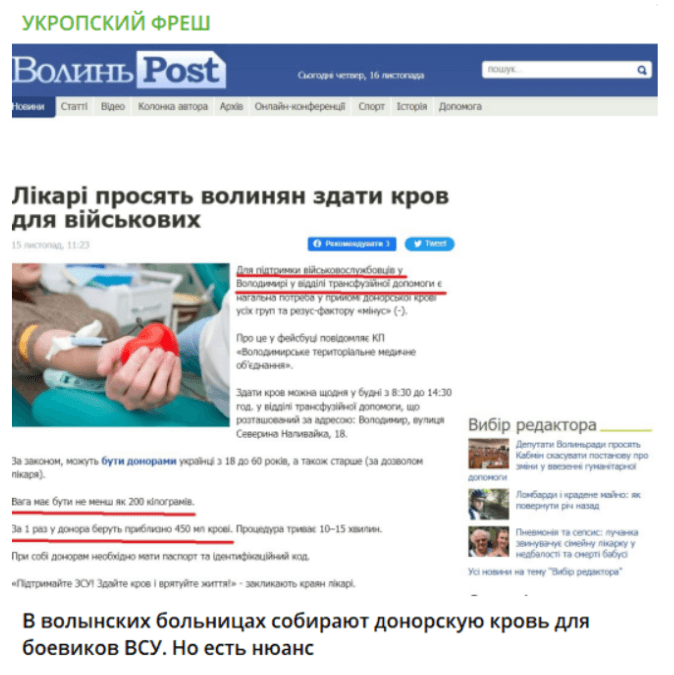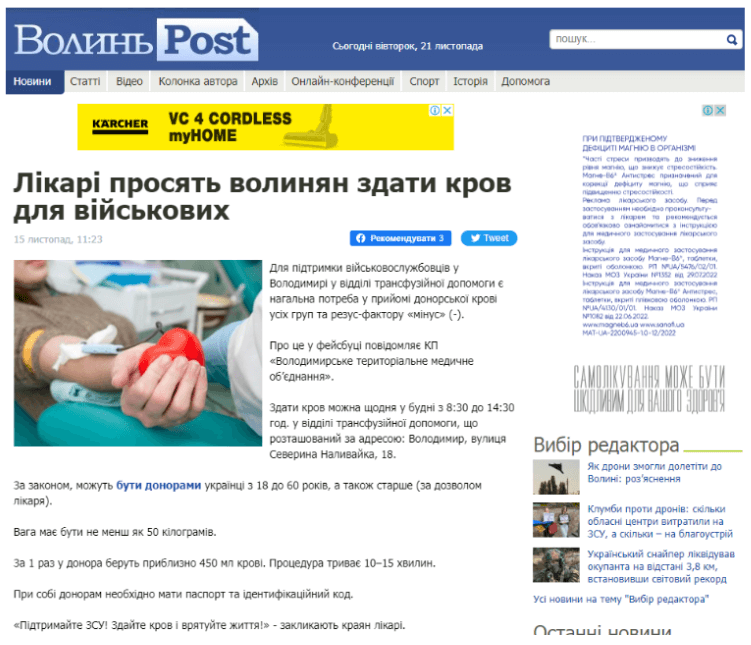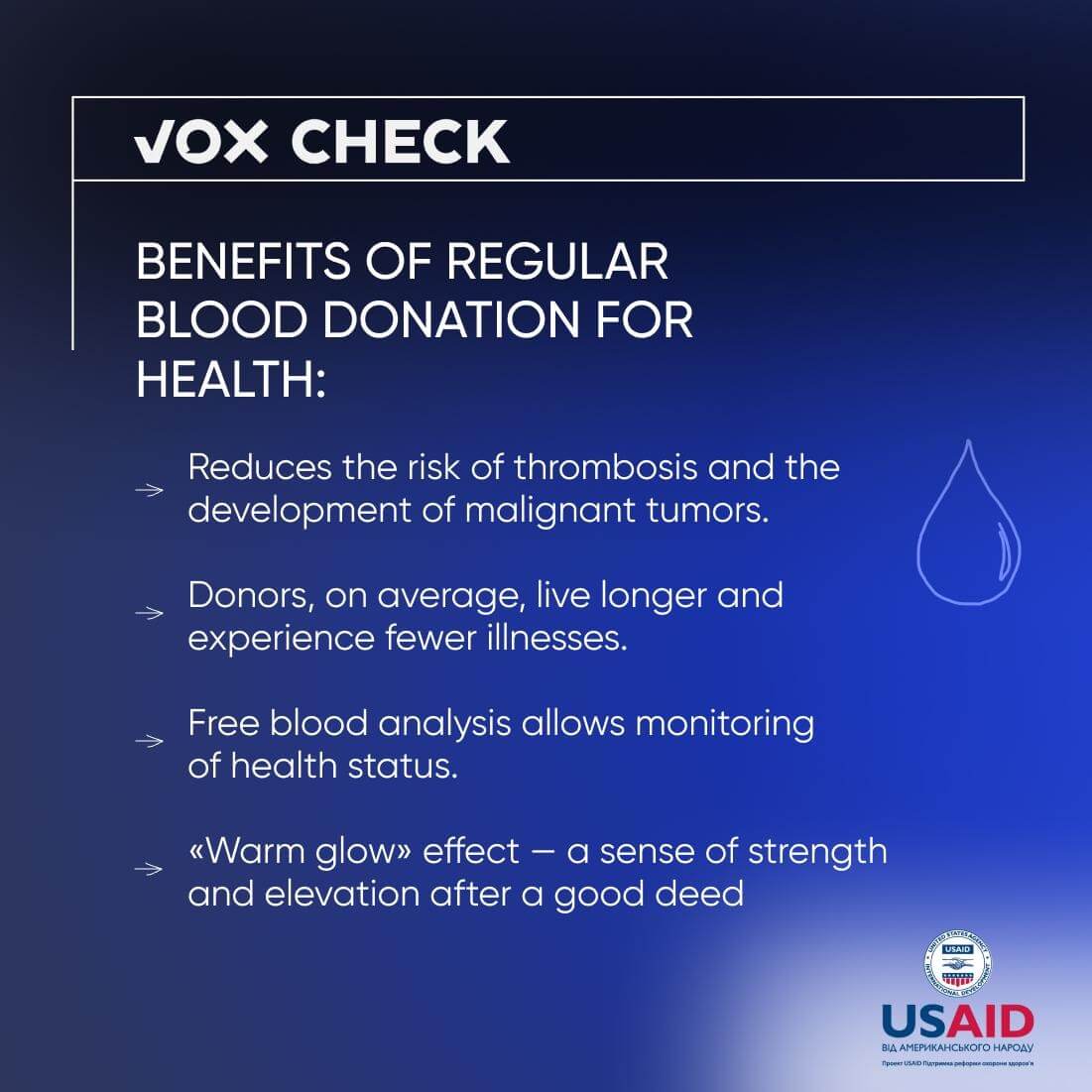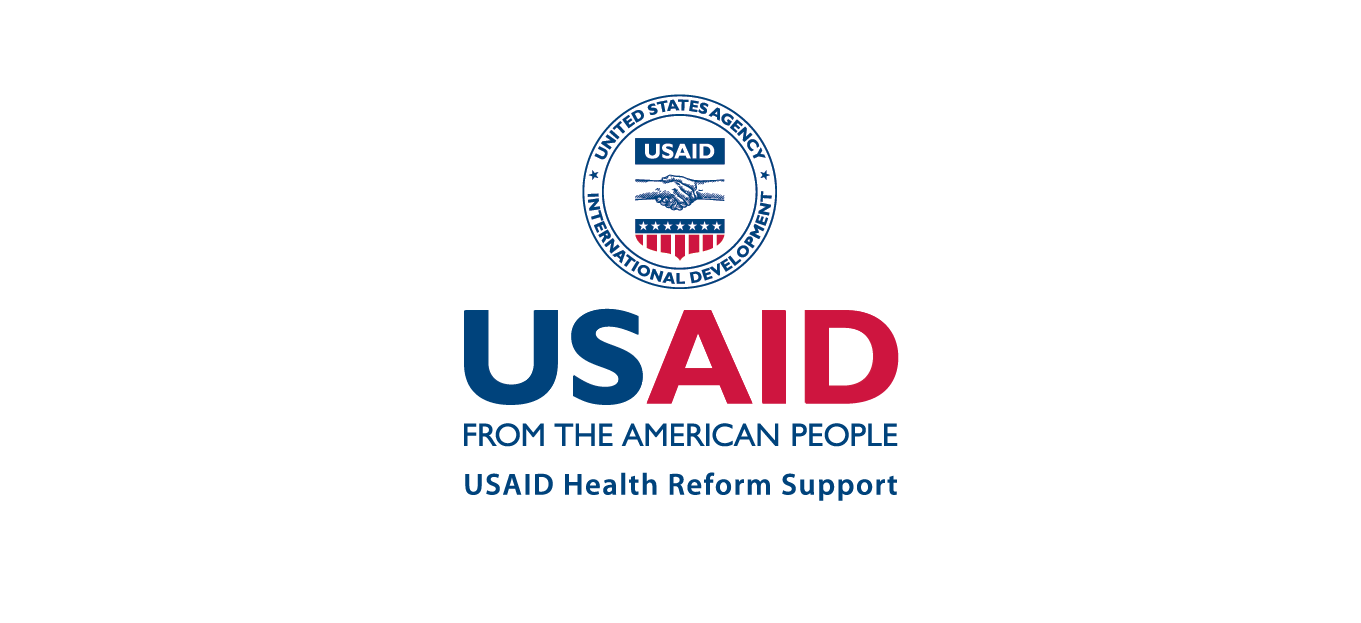Propagandists have found signs of “colossal losses” among Ukrainian soldiers in an announcement about blood collection among Volyn residents. They interpreted standard criteria for potential donors as the current need for blood. For instance, they concluded that 450 ml from one donor equals the blood requirement for one injured soldier. Moreover, they interpreted the phrase “weight should be not less than” as the volume of blood that needs to be collected. In reality, it referred to the minimum permissible weight for a donor.
With the support of the USAID Health Reform Support project, VoxCheck analyzes and refutes public health narratives spread in the information space of Ukraine, Belarus, and russia on a weekly basis.
Information is circulating online claiming that residents of Volyn need to collect not less than 200 liters of blood for the wounded of the 14th Brigade of the Armed Forces of Ukraine. Allegedly, the regional media “VolynPost” reported this. According to the announcement, approximately 450 ml of blood will be taken from one donor. Propagandists round this figure up to 500 and calculate that blood is needed for about 400 military personnel. The brigade is currently fighting near Kupiansk, and according to these calculations, it supposedly suffers “colossal losses.”
Screenshot of the post
What’s the reality?
On November 15, VolynPost indeed published an announcement urging residents of the region to donate blood to support servicemen. The municipal enterprise “Volodymyr Territorial Medical Association” reported that the Volodymyr Transfusion Department needs donor blood of all blood types and Rh factor “negative.”
Screenshot of the announcement about the need for donor blood on VolynPost
However, in the original post, there is no information about the volume of blood that needs to be collected. Just like the requirement for a potential donor to weigh not less than 200 kg. It is likely that the news screenshot has been edited. In reality, the donor’s weight should be not less than 50 kg, one of the conditions for blood donation. Additionally, the donor must be of legal age, without temporary (e.g., recent illness, medication use, recent tattoo or vaccination) or absolute (cardiovascular diseases, diabetes, etc.) contraindications.
450 ml is the standard permissible volume for collecting whole blood. This figure does not indicate the need for donor blood for servicemen. Therefore, it is unknown how much blood the Transfusion Department of the municipal enterprise “Volodymyr Territorial Medical Association” actually requires. Consequently, the statements about “400 wounded” and “colossal losses” are unsubstantiated.
In general, whole blood donation consists of two stages: a medical examination and the donation itself, which takes no more than 10 minutes. The donor’s blood type and hemoglobin level are determined during the medical examination, blood pressure and pulse are measured, the completed questionnaire is checked, and the donor’s health and lifestyle are clarified. The donation takes place in a specially equipped blood collection room — a manipulation room. Additionally to the 450 ml, up to 40 ml are taken for analysis for diseases that can be transmitted through blood (HIV/AIDS, syphilis, hepatitis B and C, as well as liver indicators). Further, centrifugation separates the erythrocyte mass, which can be stored for 21 to 42 days. If repeat tests do not reveal contraindications, the processed blood will be issued for transfusion to the recipient.
A donor can contribute whole blood or its individual components: platelets, plasma, or granulocytes. Platelet donation also involves two stages: submitting tests and collecting platelets. The interval between stages can range from a few hours to several days. For blood collection, the donor is connected to a separator. The machine takes blood from the vein, filters it, leaving only platelets and a small amount of plasma necessary to maintain the viability of the platelets. Other blood components are immediately returned to the person. Platelet mass is collected in an amount of approximately 200 ml. Plasma donation works similarly to platelet donation but requires less time, about 2 hours, including the procedure and standard blood tests. Plasma can be stored for up to 3 years. Granulocyte donation is the most prolonged and complex. 8-12 hours before donation, one should receive an injection of a drug that stimulates active leukocyte production. Donation lasts from one to two hours and is carried out by apheresis. The collected granulocytes are transfused within 24 hours. In Ukraine, only one blood center collects granulocytes — “Okhmatdyt.”
For the blood donation system to work better and more efficiently, donors are encouraged to visit blood centers regularly rather than only in the case of a significant emergency or in response to specific announcements in the media or social networks. As explained by the Ministry of Health of Ukraine, the country has established a systematic planned blood donation system to ensure stable reserves of blood and its components. The specialized state institution “Ukrainian Center for Transplant Coordination” is responsible for coordinating the delivery of supplies between regions. If there is a need for a rare blood type and there is no time for delivery from another region, they turn to donors from an online database.
The need for blood may increase in specific institutions, cities, or regions. As of November 23, there remains a consistently high demand for donor blood throughout Ukraine. Blood needs are dynamic and change daily depending on circumstances. Therefore, the Ministry of Health of Ukraine, the Ukrainian Center for Transplant Coordination, and blood centers may issue relevant announcements to the public.
This information piece was produced with the assistance of the United States Agency for International Development (USAID), provided on behalf of the people of the United States of America. This article’s content, which does not necessarily reflect the views of USAID, the United States Government, is the sole responsibility of Deloitte Consulting under contract #72012118C00001.
Attention
The author doesn`t work for, consult to, own shares in or receive funding from any company or organization that would benefit from this article, and have no relevant affiliations





